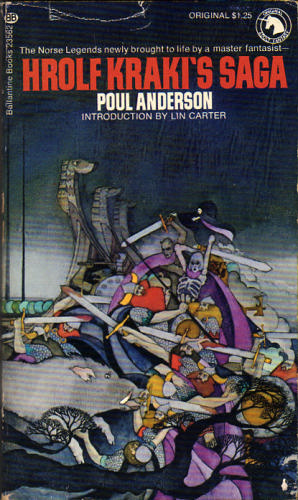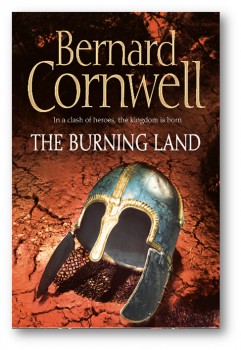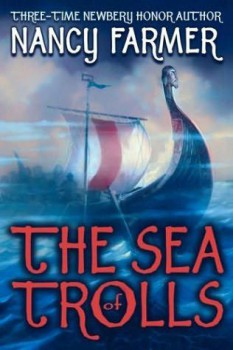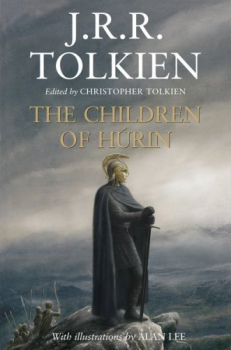In the Grip of “The Northern Thing:” My Top 10 Northern Inspired Stories
 Let us die in the doing of deeds for his sake;
Let us die in the doing of deeds for his sake;
let fright itself run afraid from our shouts;
let weapons measure the warrior’s worth.
Though life is lost, one thing will outlive us:
memory sinks not beneath the mould.
Till the Weird of the World stands unforgotten,
high under heaven, the hero’s name.
–from Hrolf Kraki’s Saga, Poul Anderson
If I had to choose a favorite sub-genre of fantasy literature it would be those writings showing the clear influence of ancient Northern mythology. Fantasy critic Lin Carter once described a group of writers including the likes of J.R.R. Tolkien, Poul Anderson, and William Morris as being possessed by “The Northern Thing”; I too am firmly in that Icelandic grip of iron. There’s just something about tales of pagan heroes possessed of grim northern courage, set against a backdrop of bleak fjords and smoldering mountain peaks and gray lowering skies, that make me want to hop on the nearest dragon-headed longship and go a-viking.
Following in no particular order are my top 10 favorite northern stories. These are stories inspired by northern myth (the Prose and Poetic Eddas), legend (the Icelandic Sagas), or history (the Danish invasions of England), and sometimes all three at once.
1. The Broken Sword, Poul Anderson. Arguably the greatest fantasy novel without the name J.R.R. Tolkien on its cover, The Broken Sword combines Norse mythology, inexorable tragic fate, faerie races vs. encroaching humanity, and Christianity vs. Paganism in a bloodthirsty, unforgettable saga.
2. Hrolf Kraki’s Saga, Poul Anderson. Anderson makes his second appearance on this list, the only author to do so. Hrolf Kraki’s Saga is a terrific, too little known novel that moves with the speed of lightning (just 260 pages) and hits with the impact of Thor’s hammer. It’s also a retelling of the life and times of an actual Danish king of the same name, and is rendered even more powerful and mythic with its tragic Arthurian overtones.
 3. The Saxon Stories, Bernard Cornwell. Uhtred of Bebbanburg is a Saxon youth captured and raised among the Danes, who then proceeds to spend the next several books in this yet-unfinished series fighting alternately for both sides in war-torn 9th century England. The Saxon Stories features Cornwell, a brilliant historical fiction writer, at his near-best (though I still prefer his Warlord Trilogy) with Viking raids, shield walls, axes, dark ages combat, hall-burnings, and general mayhem galore. Great stuff.
3. The Saxon Stories, Bernard Cornwell. Uhtred of Bebbanburg is a Saxon youth captured and raised among the Danes, who then proceeds to spend the next several books in this yet-unfinished series fighting alternately for both sides in war-torn 9th century England. The Saxon Stories features Cornwell, a brilliant historical fiction writer, at his near-best (though I still prefer his Warlord Trilogy) with Viking raids, shield walls, axes, dark ages combat, hall-burnings, and general mayhem galore. Great stuff.
4. Eaters of the Dead, Michael Crichton. Crichton was best known for his tales of science fiction, including Jurassic Park, The Andromeda Strain, Congo, Sphere, and The Lost World. But my favorite is his Eaters of the Dead, a retelling of the supposedly authentic travels of Arab Ibn Fadlan and his experiences among the Northmen circa 922 A.D.. Equally or even more so than the ripping story it tells, Eaters of the Dead is a fantastic read due to its up-close examination of viking culture, religion, and philosophy. And it’s highly quotable, too. One of my favorites: The deeds of dead men are sung, and also the deeds of heroes who live, but never are sung the deeds of ordinary men.
 5. The Sea of Trolls, Nancy Farmer. One of the better young adult books I’ve read, The Sea of Trolls pushes the genre’s envelope. Although there’s no sex and gore, it does contain a hefty measure of violence and plenty of suffering, fear, and loss. Even so I wouldn’t hesitate recommending it for teenage or adult lovers of Viking-inspired stories. The tale follows the story of a young Saxon boy named Jack and his sister Lucy, captured in a Viking raid led by Olaf One-Brow. Much adventure ensues.
5. The Sea of Trolls, Nancy Farmer. One of the better young adult books I’ve read, The Sea of Trolls pushes the genre’s envelope. Although there’s no sex and gore, it does contain a hefty measure of violence and plenty of suffering, fear, and loss. Even so I wouldn’t hesitate recommending it for teenage or adult lovers of Viking-inspired stories. The tale follows the story of a young Saxon boy named Jack and his sister Lucy, captured in a Viking raid led by Olaf One-Brow. Much adventure ensues.
6. American Gods, Neil Gaiman. A ex-convict known as Shadow is approached by a large, bearded, one-eyed man named Wednesday, who turns out to be none other than Odin the All-Father, chief god of the Norse pantheon. Wednesday hires Shadow to be his assistant in what we soon find to be a coming great war—a modern-day Ragnarok—between the old, dying, mostly forgotten gods of dozens of ancient cultures, and the new “American Gods” of wealth, technology, television, and sex. A brilliant book and a marvelous reworking not only of northern myth, but many other cultures as well.
7. Eric Brighteyes, H. Rider Haggard. Recommended to me recently by Jesse Willis of SFFaudio.com, Haggard’s 1890 novel is now one of my favorites. The Icelandic sagas at their heart share a bleakness of vision—a belief that fate is unchangeable, and that all roads end in darkness. In Eric Brighteyes fate is depicted as a tapestry woven by the Three Fates, aka the Norns. Our lives are as threads in this grand but finite pattern, shorn off by the weaver at the Norns’ appointed time. Eric is the archetype of the Nordic hero: Blond, handsome, fearless, and mighty in arms and feats of strength. Yet for all his strength he too is subject to the same forces that rule all men.
8. Beowulf (Seamus Heaney translation). Beowulf can be read for its straightforward yet compelling story, but the real reward of the ancient epic poem is its wonderful language. Heaney’s translation is a joy to listen to: Great warriors are “wreckers of mead-benches” and kings are “generous ring-givers.” The ocean is a “whale road,” the sun “the world’s candle,” a gleaming sword a “battle-torch.” Favorite quote: For every one of us, living in this world means waiting for our end. Let anyone who can win glory before death. When a warrior is gone, that will be his best and only bulwark.
9. The Frost Giant’s Daughter, Robert E. Howard. While not accorded one of Howard’s best short stories, The Frost Giant’s Daughter has always resonated with me due to its Northern elements—a clash of Vanir and Aesir on a white illimitable plain, ice-choked mountains, bearded giants, Conan in pursuit of the fair-haired goddess Atali, and the intervention of the god Ymir, who whisks his daughter away from the young Cimmerian’s clutches. It’s a beautifully written interlude by one of fantasy’s best authors.
 10. The Children of Hurin, J.R.R. Tolkien. I was tempted to pick the entirety of The Silmarillion, but The Children of Hurin is Tolkien’s version of “The Northern Thing” in its purest distillation. Tolkien was heavily influenced by Northern myth and it’s none more evident than in The Children of Hurin. Heroic and studded with mighty deeds and feats of arms, but bleak, tragic, and ultimately fruitless, this is Tolkien in his darkest (and most Northern) hour.
10. The Children of Hurin, J.R.R. Tolkien. I was tempted to pick the entirety of The Silmarillion, but The Children of Hurin is Tolkien’s version of “The Northern Thing” in its purest distillation. Tolkien was heavily influenced by Northern myth and it’s none more evident than in The Children of Hurin. Heroic and studded with mighty deeds and feats of arms, but bleak, tragic, and ultimately fruitless, this is Tolkien in his darkest (and most Northern) hour.
As much as I love “The Northern Thing” there are some northern stories which I have not yet read (but mean to one day). These include Robert Low’s Oathsworn series, E.R. Eddison’s Styrbiorn the Strong, and The Long Ships by Frans Gunnar Bengtsson.
What are your favorites?
This is a great post. I haven’t read the Anderson books you mention, but I did read Three Hearts And Three Lions some time ago, and greatly enjoyed it (probably time for a re-read, come to that). Beowulf is great, and I’d also mention Widsith and The Wanderer — something about those poems evokes an entire worldview, not only a bleak landscape but a whole way of life.
In terms of other works … I have to admit some partiality for Richard Wagner’s Ring operas. They’re so thoroughly thought-through, so packed with dramatic and musicological meaning.
You mentioned William Morris at the beginning of your piece; I’ve been reading and re-reading a fair amount of Morris lately. I enjoy his work quite a bit, and I find his style not only a wonderful use of the language, but often quite affecting.
Other material … Leiber’s Fafhrd and the Grey Mouser stories were some of the first stories I came across to work with Northern cultures in the way you’re talking about here. I also find myself thinking of the Viking bits of John Myers Myers’ Silverlock.
But I mainly want to mention something perhaps unexpected: three specific runs of Marvel Comics’ Thor, and associated titles. The first, of course, is the classic Lee/Kirby run from the 60s; it took the creators a while to understand the richness of the material they had to hand, but once they did, Kirby in particular really began producing mind-blowing stuff, re-interpreting myth and fusing it with science and cosmic power. In the early 80s, Walt Simonson took over the title, and again produced powerful work by returning to the mythic roots of the characters. His art and storytelling was striking, but his whole approach to the title gained even more strength through invoking a sense of saga and folktale — from the former villain Skurge’s heroic last stand on the bridge of Hel, to Thor encountering the last Viking, to the unexpected fairy-tale wit of the Frog of Thunder (seriously, you have to read it to understand).
Finally, there was a great set of books a few years after Simonson’s work, written by Alan Zelenetz and drawn by Charles Vess. These books didn’t deal with Thor himself, for the most part. The Raven Banner graphic novel was a story set in a fairy-tale-like Asgard, about duty, love and death; while a four-issue run in the anthology series Marvel Fanfare starred Thor’s buddies The Warriors Three in a humorous but still fantastic and mythic tale. Wonderful material, too-little-known.
Thanks David. I do recommend Hrolf Kraki’s Saga, The Broken Sword, and I’d also add in War of the Gods for good measure. War of the Gods is also a great tale in the northern tradition but I couldn’t possibly add a third title by Anderson in a top 10 list.
Thanks for the Widsith and the Wanderer suggestion.
Regarding Marvel’s Thor, while I haven’t read too much of that particular comic, the few storylines I have encountered have been pretty good. What you’ve described here sounds pretty awesome. I used to be a loyal follower of Captain America and would never part with my back issues.
A newer book of ‘the northern thing’ would be Weis & Hickman’s new Dragonships of Vindras series. The first book being called ‘Bones of the Dragon’. its pretty good it feels alot different from anything i’ve read from them.
This is just the post I have been looking for. I have been hankering for some Viking fiction to add to my ever-growing stack of “to reads.”
I am a huge fan of Beowulf, in all of its incarnations. You’ve already mentioned one of my favorites in Eaters of the Dead (LOVE the movie as well), but I would also mention “Whose Song is Sung”by Frank Schaefer. It tells the story through the eyes of a dwarf, and paints the hero in an interesting new light.
Additionally, I recommend the Ranger’s Apprentice young adult series. A fictionalized version of Norsemen appear in the later books, and it’s just a great series in general.
Do yourself a favor and read Rhinegold by Stephan Grundy. It fits squarely into the ‘Northern Thing’ category. It crosses norse mythology and ancient scandanavian history. Its gritty, and dire, full of tragedy and rests squarely on the innate strength of the men and women of the time. Broken Sword and Rhinegold are absolutely in my top 5 books of any kind.
I had a great time reading Tim Severin’s Viking trilogy: very rich in historical information but not lacking adventure whatsoever: a delight!
[…] “In the grip of “The Northern Thing:” My Top 10 Northern Inspired Stories” (here), in which he examines Poul Anderson’s Hrolf Kraki’s Saga and The Broken Sword, Nancy […]
After really enjoying the article on The Broken Sword, I was recommended to read this one and I’m sure glad I did because it’s excellent!…and made me realize “I’ve got to join this site!”. So I did. I am big into the Northern Thing, having already read all the Anderson books mentioned here, though I was surprised to see that Mother Of Kings, one I want to read, wasn’t, since it looks to be great – feel like I saw it somewhere on the site? I just recently posted a review of Nancy Farmer’s The Sea Of Trolls on Goodreads.com, have read a couple of translations of Beowulf, and have read The Children Of Hurin many times. Also grew up on Thor comics, own Eaters Of The Dead but haven’t read it, and read several books mentioned in the comments to this article. Really interested in reading Rhinegold by Stephan Grundy thanks to westerosRising’s recommendation. I want to agree that Ring Of The Nibelung is really cool. It has obvious parallels to Beowulf and seems to have been Tolkien’s bible. I’ve always wondered if Harry Harrison’s Hammer and the Cross series is good – Anyone? Looks good though I understand it is more Norse influenced than actual. While the historical Northern stories seem interesting, I am more enamored with the tales that have a touch of supernature. I would also mention that Katherine Langrish’s Troll Fell series is a Nordic Scandinavian influenced fun story, but is more of a a Brothers Grimm-type fairy tale than a sword and sorcery fantasy novel. Here’s where I put my 2 ¢ents in: The Knight and The Wizard by Gene Wolfe is a high recommendation and anybody that tells me they didn’t like it is either too lazy a reader, missing the magic of true storytelling or been reading too many Terry Brooks Goodkind novels – which I like a bit more than most, but they lack the depth, research and poetic touch of a master storyteller like Gene Wolfe. But, that is not all I have to offer you hungry Northern Things. There is an absolutely wonderful short story, probably easiest to find in the anthology collection titled Werewolf! edited by the very knowledgable, Bill Pronzini. I won’t give away the details, except to say it is called The Were-Wolf, written by Clemence Housman and it is a fantasy short story not to be missed by anyone. I would go so far as to say it could’ve almost been written by Poul Anderson himself, though it was first published in 1896.
Hi Michael, welcome to Black Gate! I’m glad you enjoyed my top ten list. It was really only intended as a thumbnail sketch of my favorite titles, arbitrarily capped at 10. There are many other titles to enjoy.
I have read the first in The Hammer and the Cross series and found it to be a decent, if bloodthirsty read. Not exactly high art, but action-packed and quite graphic (blood eagles and so forth).
I have not read The Knight and the Wizard nor the Housman story, though I have read and highly recommend her novel The Life of Sir Aglovale de Galis, a thoughtful examination of the incompaitabilty with truth vs. the institution of chivalry. Thanks for the recommendations!
[…] many others I am in thrall to “the Northern thing.” Some of the earliest fantasy authors such as […]
casino…
Black Gate » Blog Archive » In the Grip of âThe Northern Thing:â My Top 10 Northern Inspired Stories…
I’d like to add Henry Treece, a far superior writer to most, who wrote novels about Vikings etc, as well as fictionalised Greek myth, but whose ‘Dark Island’ tetralogy has a wonderful sense of the pre-Chrustian mind-set. The Dark Island, The Golden Strangers, The Great Captains (historical Arthur) and Red Queen.White Queen are the four. The only supernatural elements are in their understanding what they perceive.
[…] Fiction (DMR Books): Howden Smith is perhaps better known for his epic Grey Maiden series, recently reprinted by Altus Press. But he worked very fluidly and convincingly in the Viking era. Howden Smith apparently based the Swain tales upon the Orkneyinga Saga, the Norse account of the jarls (earls) of the Orkney isles north of Scotland. I’ve got bit of a Viking fetish so this is like throwing red meat to the fan base. See some of my prior posts on the Northern Thing here. […]